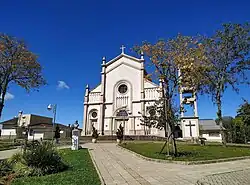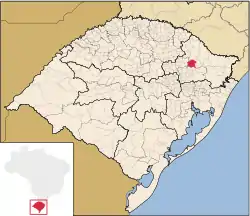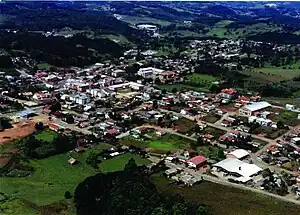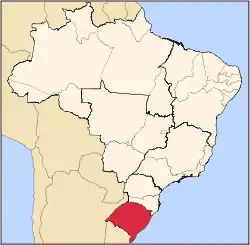Ipê, Rio Grande do Sul | |
|---|---|
 Igreja Matriz São Luiz Rei located at Praça Frei Eduardo Totti | |
 Flag  Coat of arms | |
| Motto(s): Ipê, uma cidade para todos | |
| Anthem: s:Hino do município de Ipê | |
 | |
 Location in Brazil | |
| Coordinates: 28°49′12″S 51°16′44″W / 28.82000°S 51.27889°W | |
| Country | |
| Region | South |
| State | |
| Founded | 15 December 1987 |
| Government | |
| • Mayor | José Mario Grazziotin [1] (MDB) |
| Area | |
| • Total | 599.361 km2 (231.415 sq mi) |
| Lowest elevation | 750 m (2,460 ft) |
| Population (2022)[2] | |
| • Total | 5,325 |
| • Density | 8.9/km2 (23/sq mi) |
| Demonym | Ipeense |
| Time zone | UTC-3 (UTC-3) |
| • Summer (DST) | Does not observe DST |
| Postal Code | 95240-000 |
| Area code | +55 54 |
| HDI (2010) | 0.728– high[3] |
| Website | www |
Ipê (Portuguese pronunciation: [ipe]) is a municipality in the state of Rio Grande do Sul, Brazil. As of 2020, the estimated population was 5,325.[4]
History
The history of the municipality of Ipê began in the late 19th century, around 1880, with the passage and resting of muleteers who, departing from the fields of Vacaria, headed through the Serra do Rio das Antas towards São Leopoldo.[5] Until then, the ancient forests that covered the lands of Ipê remained almost untouched, with only indigenous people traversing the region, which was covered with vast pine groves from which they derived sustenance.
Gradually, the region began to be settled by farmers who cultivated corn and built various rudimentary houses, inhabited by Luso-Brazilians who were descendants of slaves from cattle ranches. These houses were made of beaten earth, split planks, and roofed with small boards.
Later, Italian immigrants, arriving from São Sebastião do Caí, would reach the region by boat, then travel on foot or horseback to settle in the Colony of Antônio Prado and the area that would become the Municipality of Ipê.
The Italian colonists who arrived in the area contributed to its prosperity. On December 31, 1890, the Municipal Chamber of Vacaria created the 4th District, which, due to the abundant presence of the beautiful Ipê tree, was named Vila Ipê.
As the community grew, ideas of emancipation began to surface. In 1985, the then parish priest of the São Luiz Rei Parish, Frei Augusto Denardi, initiated the formation of the Community Commission for Emancipation. On September 6, 1985, in a meeting held at the Ideal Club with local leaders and residents of Vila Ipê, Vila Segredo, and Vila São Paulo, respectively, the 4th, 9th, and 11th districts of Vacaria, the Emancipation Commission was chosen by acclamation, with the following members: Osmar Vargas dos Santos (President), Frei Casimiro Zaffonato (Vice-President), Cirilo Ciotta (1st Secretary), Carlos Antonio Zanotto (2nd Secretary), Uldérico Marcon (1st Treasurer), Darci Luiz Lovatel (2nd Treasurer), Delvino Magro (Subcommission of Vila Segredo), and Luiz Antônio Salvador (Subcommission of Vila São Paulo).
On September 21, 1987, the result of the plebiscite proclaimed the victory of "YES," with 2,604 votes in favor and 465 against. On December 15, 1987, a law was promulgated by then-Governor Pedro Simon, which created the Municipality of Ipê, constituted by the districts of Vila Ipê, Vila Segredo, and Vila São Paulo, which previously belonged to the Municipality of Vacaria. The seat of the new municipality was established in Vila Ipê.
On January 1, 1989, the Municipality of Ipê was administratively installed, with Mr. Protázio Duarte Guazzelli serving as the first elected mayor.
The demonym for the residents of Ipê is "ipeense."
Administrative Formation
- The district of São Luiz de França was created by municipal act number 696 on December 31, 1890, under the jurisdiction of the Municipality of Vacaria.
- In 1938, the district was named Colônia São Luís de França.
- In 1938, the district was named Ipê.
- In the administrative divisions of 1960, 1983, 1993, and 2007, the district of Ipê remained under the jurisdiction of the Municipality of Vacaria.
- In 1987, Law 8,482 was promulgated, creating the Municipality of Ipê, separated from Vacaria. The municipality included the districts of Vila Ipê, Vila Segredo, and Vila São Paulo. The seat of the new municipality was located in Vila Ipê.
- The administrative installation of the Municipality of Ipê occurred on January 1, 1989.[5]
Nomenclatures
| Nomenclatures[6] | Years |
|---|---|
| Formigueiro[1] | 1886 |
| São Luiz | 1890 |
| Vila Ipê | 1936 |
| Ipê* | 1987 |
Leaders
| Nº | Name | Start of term | End of term | Observation |
|---|---|---|---|---|
| 1 | Protázio Duarte Guazzeli | 1989 | 1992 | |
| 2 | Enaudy Sartor | 1993 | 1996 | |
| 3 | Darci Zanotto | 1997 | 2000 | |
| 4 | Darci Zanotto | 2001 | 2004 | |
| 5 | Carlos Antônio Zanotto | 2005 | 2008 | |
| 6 | Carlos Antônio Zanotto | 2000 | 2012 | |
| 7 | Valerio Ernesto Marcon | 2013 | 2016 | |
| 8 | Valerio Ernesto Marcon | 2017 | 2020 | |
| 9 | Cassiano de Zorzi Caon | 2021 | *2023 [a] | Incomplete mandate |
| 9.1 | José Mário Grazziotin[9][10] | 2023 | 2024 | Swearing-in of the Vice Mayor |
Subdivisions
| District[5] | Population[13] |
|---|---|
| Ipê | 3700 |
| Vila São Paulo | 800 |
| Vila Segredo | 1200 |
Vila São Paulo
Was established as a district on August 5, 1953, covering an area of 180 square kilometers. The landscape of this district is characterized by hilly terrain, with small and mini rural properties being predominant. Larger properties are rare, especially in the flat area known as the 'campo.' Approximately 95% of the population in Vila São Paulo is involved in agricultural and livestock activities, while 2% are engaged in commerce, 2% in industry, and 1% in the provision of services. In the headquarters of the 3rd District, which is Vila São Paulo, there are various commercial, service, and industrial establishments to serve the population.[14]
Vila Segredo
Was established as a district on February 7, 1924, covering an area of 295 square kilometers. The region is characterized by its hilly terrain, primarily composed of small and mini rural properties. About 90% of the population in Vila Segredo is involved in agricultural and livestock activities, 2% in commerce, 3% in industry, and 5% in the provision of services. The main source of income for the district is the cultivation of apples and grapes, which are permanent crops well suited to the rugged topography of the region. Similar to Vila São Paulo, the headquarters of the 2nd District, which is Vila Segredo, has a variety of commercial, service, and industrial establishments.[14]

See also
References
- ↑
- ↑
- ↑ "Ranking". United Nations Development Programme (UNDP). Retrieved May 12, 2023.
- ↑ IBGE 2020
- 1 2 3 Instituto Brasileiro de Geografia e Estatística. "O histórico de Ipê" (PDF). Archived from the original (PDF) on 25 March 2018. Retrieved 8 February 2012.
- ↑ Webde. "History". Municipality of Ipê (in Brazilian Portuguese). Retrieved 2023-10-26.
- ↑ "Formigueiro, o primeiro nome". cidades.ibge.gov.br. Retrieved 2023-10-26.
- ↑ "ex-mayors".
- ↑ Webde. "JOSÉ MÁRIO GRAZZIOTIN EMPOSSADO PREFEITO MUNICIPAL DE IPÊ - Notícias". Prefeitura Municipal de Ipê (in Brazilian Portuguese). Retrieved 2023-11-08.
- ↑ "Após morte de prefeito, vice toma posse na prefeitura de Ipê | Pioneiro". GZH (in Brazilian Portuguese). 2023-11-07. Retrieved 2023-11-11.
- ↑ "Prefeito de Ipê, Cassiano Caon é encontrado morto | Pioneiro". GZH (in Brazilian Portuguese). 2023-11-04. Retrieved 2023-11-04.
- ↑ portoalegre24horas. "Prefeito de cidade no RS é encontrado morto no interior do município". Terra (in Brazilian Portuguese). Retrieved 2023-11-04.
{{cite web}}: CS1 maint: numeric names: authors list (link) - ↑ Instituto Brasileiro de Geografia e Estatística. "Censo Demográfico 2022". Retrieved 23 October 2023.
- 1 2 "Districts".
